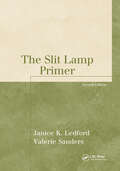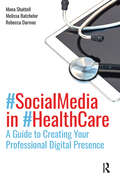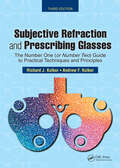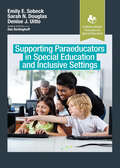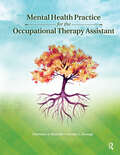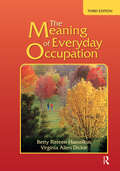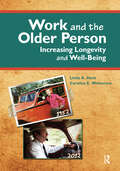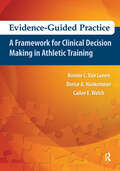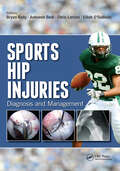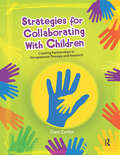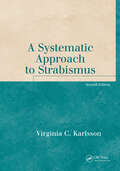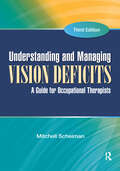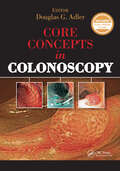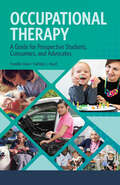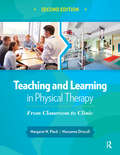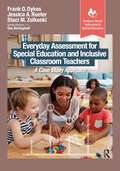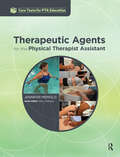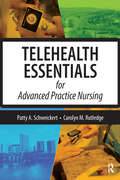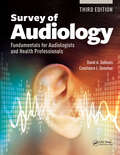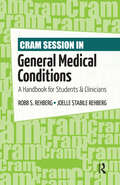- Table View
- List View
The Slit Lamp Primer (The Basic Bookshelf for Eyecare Professionals)
by Janice K. LedfordThe Slit Lamp Primer is the complete book on the slit lamp for the ophthalmic and optometric office. Now updated into a second edition, this user-friendly introduction to the slit lamp microscope highlights the instrument's basic parts as well as examination and illumination techniques. Janice Ledford and Valerie Sanders explain more than just the fundamentals of the slit lamp. Written in a conversational style with supplemental photographs and diagrams, The Slit Lamp Primer delves into issues concerning the normal, postoperative, and problematic eye. Features of the patient history, including medications, are examined in light of the possible slit lamp findings. Detailed notes for proper documentation are included, along with tables to give guidelines for subjective grading of the findings. Updated and key features: The examination of patients on various systemic medications with a list of drugs that may have side effects visible with the slit lamp The examination of post-operative patients, with a new section that focuses on patients who have undergone refractive surgery Up-to-date study icons, key points listed at the beginning of each chapter, and "What the Patient Needs to Know" sidebars Photographs and descriptions of parts and care of the slit lamp Atlas of photographs of the normal eye Photographs of pathology Tables to assist in contact lens evaluation The Slit Lamp Primer, Second Edition is a valuable addition to the reference library of any ophthalmic and optometric paraprofessional or student. Explore the workings of a useful and effective instrument with the most practical and user-friendly book on the subject available today.
Social Media in Health Care: A Guide to Creating Your Professional Digital Presence
A practical, essential guide to social media for health care professionals, Social Media in Health Care equips readers with the skills to build their online brand, share their professional knowledge with a wider audience, and become a trusted source of information and thought leader in their field.Authors Mona Shattell, Melissa Batchelor, and Rebecca Darmoc explain the principles behind building a respected digital presence and developing meaningful online connections, while providing practical tips for navigating the five major social media platforms: Twitter, LinkedIn, Facebook, Instagram, and YouTube. Everyone from health care students to the most seasoned professionals will benefit from the 3C’s Framework outlined in the book: Consume, Contribute, and Create.Social Media in Health Care can be read cover to cover or used as quick reference guide. Topics include: Exercises for novice, intermediate, and advanced users Best practices for consuming, sharing, and creating content Tips for readers to build their social media presence and professional brand Recommendations for using digital platforms to expand professional networks Patient privacy concerns and how to avoid ethical pitfalls Social media can start conversations and serve as an open line of communication between peers, the public, and patients. Social Media in Health Care guides members of the medical community in how to use social media to help educate the public and specific patient communities about health care and health policy, make connections with industry leaders and peers, and enhance their professional reputation.
Subjective Refraction and Prescribing Glasses: The Number One (or Number Two) Guide to Practical Techniques and Principles, Third Edition
by Richard KolkerBasic refraction is a foundational part of ophthalmology, and yet beginning ophthalmology residents and ophthalmic technicians are often left on their own to learn the finer points. Despite being core skills, the techniques and practical aspects of subjective refraction and prescribing glasses are often developed by trial and error, if they are developed at all.Subjective Refraction and Prescribing Glasses: The Number One (or Number Two) Guide to Practical Techniques and Principles, Third Edition is designed as a complete guide to those essential skills, offering everything from basic terminology to tips, tricks, and best practices. This updated Third Edition has been expanded in every section with thoughtful, practical advice, and has case scenarios, in a question and answer format, of situations encountered with real-world patients. It is the most comprehensive review of clinical subjective refraction to date. Drs. Richard Kolker and Andrew Kolker together have nearly 50 years of experience in the practice of ophthalmology and bring both the fresh eyes of a beginning ophthalmologist and the experience of a seasoned veteran to this Third Edition. While new residents and technicians will appreciate the thorough explanation of refractive fundamentals, even expert ophthalmologists will appreciate the practical tips that may have never occurred to them. Included are: Very clear, easy-to-read, practical explanations of the subjective refraction process Basic practical optics to explain the steps of subjective refraction The Jackson Cross Cylinder made easy to understand and use Plus and mInus cylinder methods discussed separately and color coded for quick identification An Appendix with a primer on retinoscopy and how to use the manual lensometer The art of subjective refraction and prescribing glasses Subjective Refraction and Prescribing Glasses: The Number One (or Number Two) Guide to Practical Techniques and Principles, Third Edition is the definitive guide to the often neglected skills involved in clinical subjective refraction. Residents and technicians will find it a critical guide in their learning process, but even seasoned ophthalmologists can benefit from the tips and tricks enclosed within.
Supporting Paraeducators in Special Education and Inclusive Settings (Evidence-Based Instruction in Special Education)
by Sarah Douglas Emily Sobeck Denise UittoSupporting Paraeducators in Special Education and Inclusive Settings provides an in-depth look at the role of pre- and in-service teachers as supervisors of paraeducators within special education and inclusive settings.The latest entry within the Evidence-Based Instruction in Special Education series, Supporting Paraeducators in Special Education and Inclusive Settings serves as an instructional tool for pre-service teachers and educators within higher education coursework, as well as a resource for in-service teachers. This text supports teachers in strengthening their knowledge and supervisory skills necessary to supervise and manage paraeducators in educational environments.Through objectives, scenarios, content, and chapter questions, Drs. Sobeck, Douglas, and Uitto provide a thorough and applicable overview of working with and supervising paraeducators. In this text the roles and responsibilities of paraeducators, teachers, and school administrators relative to paraeducator training and supervision will be detailed, as well as tips for collaboration.Included with the text are online supplemental materials for faculty use. School leaders and higher education faculty can use the online site for materials to support pre-service training within teacher preparation programs and professional development for in-service teachers.Supporting Paraeducators in Special Education and Inclusive Settings fills an important need in the field and is a vital resource for current and future teachers when working with paraeducators.
Mental Health Practice for the Occupational Therapy Assistant
by Christine Manville Jeremy KeoughMental Health Practice for the Occupational Therapy Assistant is a comprehensive text that delineates the role of the occupational therapy assistant in the delivery of mental health services. Christine Manville and Jeremy Keough provide information and learning activities that enable the student to build knowledge of mental health practice, incorporating approaches used in the traditional medical model, as well as the community. The impact of mental illness on occupational performance across the lifespan is also examined.Mental Health Practice for the Occupational Therapy Assistant guides the reader in how to analyze the service environment, including cultural, societal and political factors; explore the client’s participation in age-appropriate, meaningful occupations; and, under supervision of the occupational therapist, provide treatment that includes 1:1 and group interventions.Mental Health Practice for the Occupational Therapy Assistant structures each chapter to provide an enhanced approach to student learning by incorporating concepts from Bloom’s Taxonomy. Current and emerging trends in mental health practice are discussed, as well as service provision in the traditional medical model. The appendices include a discussion of additional factors that impact the provision and efficacy of therapy services, including pharmacology and ethical and legal issues.Features: Provides an overview of the DSM-5 and the World Health Organization’s International Classification of Functioning, Disability, and Health. These classification systems provide a common language for practitioners from a variety of disciplines to communicate about the impact of mental illness on occupational performance and participation Describes the use of general educational strategies to enhance the teaching/learning process in the provision of occupational therapy services Terminology from the Occupational Therapy Practice Framework, Third Edition is utilized to enhance the development of clinical reasoning and practice skills Provides information on how to communicate effectively with clients Mental health practice is viewed across the lifespan Instructor’s materials include PowerPoint presentations, student study sheets, tests questions, and application questions for each chapter Included with the text are online supplemental materials for faculty use in the classroom.Mental Health Practice for the Occupational Therapy Assistant is an excellent side-by-side resource for the occupational therapy assistant, occupational therapist, or any practitioner working in a mental health setting.
The Meaning of Everyday Occupation
by Betty Risteen Hasselkus Virginia DickieNewly updated to address emerging directions in occupational therapy and occupational science, The Meaning of Everyday Occupation, Third Edition encourages occupational therapy personnel—students, educators, researchers, and practitioners—to recognize humans as occupational beings and to understand the meaning and significance of everyday occupation in day-to-day life. Written by award-winning and internationally known authors Drs. Betty Risteen Hasselkus and Virginia Allen Dickie, the Third Edition explores the concept of meaning as it relates to occupation in daily life. Each chapter is augmented by the authors’ personal reflections, narratives from occupational therapists in practice, and quotations from participants in the authors’ occupational research, creating a text in which the concepts and theories of occupation and occupational therapy come alive for the reader. Themes in the Third Edition include: Meaning in everyday life and its occupations Space and place as sources of meaning Culture in everyday occupation and in the context of therapy Well-being and development through everyday occupation Occupation as connection Disability and occupation Occupation and the human spirit Everyday creativity Emphasizing occupation as experience, the comprehensive Third Edition champions the contributions of meaning to a client-centered approach to practice. This brings forward a new understanding of how to therapeutically affect the systems in which we all live and work. The everyday occupation of our lives is often overlooked. By increasing the visibility of everyday occupation, The Meaning of Everyday Occupation, Third Edition offers readers the opportunity for personal reflection on day-to-day occupational patterns. By recognizing and acknowledging these patterns in their own lives, occupational therapy personnel can better understand how day-to-day occupation and disruption of that occupation affects the lives of clients.
Work and the Older Person: Increasing Longevity and Wellbeing
by Linda Hunt Caroline WolversonPart exploration, part knowledge building, and part narration, Work and the Older Person: Increasing Longevity and Well-Being draws on the latest research from a variety of disciplines and resources to paint a complete picture of productivity in old age. Dr. Linda A. Hunt and Caroline E. Wolverson, along with 11 contributors, discuss the relationship between work and aging and highlight the importance of working into old age. Each chapter of Work and the Older Person focuses on narratives from older workers that support the evidence presented with personal stories. These stories illustrate the opportunities, challenges, frustrations, and choices that older people face in maintaining a productive lifestyle. Simultaneously, the text highlights current events and the economy largely within Western societies and discusses the struggle some countries have supplying the financial benefits paid to retirees. Overall, the text shows how working into old age can contribute to longevity and greater quality of life. Occupational therapists, occupational therapy assistants, gerontologists, social workers, psychologists, and those working with older people in the health and social care sector will appreciate the inspiring accounts from older workers discussing how work contributes to their self-identity, quality of life, health, and well-being.Work and the Older Person: Increasing Longevity and Well-Being shows how engaging in occupations brings purpose to people’s lives. The text will be of value to all professionals working with older adults, as well as older adults themselves looking to maintain a productive lifestyle.
Evidence-Guided Practice: A Framework for Clinical Decision Making in Athletic Training
by Bonnie Van Lunen Dorice Hankemeier Cailee WelchAthletic trainers must have a foundation in the concepts of evidence-based practice to deliver patient care in an effective way. It is critical that students and clinicians formulate clinical plans that will be effective for individual patients. With that goal in mind, Evidence-Guided Practice: A Framework for Clinical Decision Making in Athletic Training teaches the athletic trainer that evidence-based practice concepts must be incorporated into daily clinical practice. Written in a conversational tone, Drs. Bonnie Van Lunen, Dorice Hankemeier, and Cailee Welch provide a practical and concise resource for athletic trainers to use when interpreting what the available evidence means for them and how it can be effectively applied in daily patient care. The competencies within athletic training and other health care professions were considered when each chapter was constructed. Special care was taken to include examples that are specific to athletic training and instructional applications for educators.What Is Inside: Types of research design Foundations of research and statistics Introduction to critical appraisal Concepts of validity Diagnostic accuracy Disablement models Patient-oriented outcome assessments Health care informatics The first of its kind, Evidence-Guided Practice: A Framework for Clinical Decision Making in Athletic Training is the only resource athletic training students, clinicians, or other health care professionals will need to properly put evidence-based concepts into practice.
Sports Hip Injuries: Diagnosis and Management
by Bryan Kelly Asheesh Bedi Chris Larson Eilish O'SullivanIn the world of sports, hip injuries among an athletic population can be very difficult to diagnose and manage. That’s why Sports Hip Injuries: Diagnosis and Management is a comprehensive guide to diagnosing and managing sports hip injuries and hip preservation. Drs. Bryan Kelly, Asheesh Bedi, Chris Larson, and Eilish O’Sullivan are leaders in the field of hip preservation. They present Sports Hip Injuries: Diagnosis and Management in a concise manner by focusing on hip and pelvis disorders and cover all of the typical disorders seen in athletes presenting with hip and pelvic pain. The anatomy, presentation, clinical evaluation, imaging, nonsurgical and surgical treatment, and post-surgical rehabilitation of hip joint disorders are presented clearly throughout.Some of the topics Include: Femoroacetabular impingement Hip instability/dysplasia Athletic pubalgia/core muscle injury Stress fractures and traumatic sports injuries of the hip and pelvis Myotendinous injuries and nerve entrapment disorders of the hip and pelvis Rehabilitation guidelines and return to sport outcomes Sports Hip Injuries: Diagnosis and Management is an invaluable resource for sports medicine providers including orthopedic surgeons and fellows that care for patients presenting with hip pain for athletes at all levels, as well as physical therapists and athletic trainers.
Strategies for Collaborating With Children: Creating Partnerships in Occupational Therapy and Research
by Clare CurtinStrategies for Collaborating With Children: Creating Partnerships in Occupational Therapy and Research applies client-centered and strengths-based theories to pediatric practice. The text is organized using a research-based conceptual model of collaboration. Within this text, there are detailed descriptions of how to engage and work with children aged 3 to 12 years, from the beginning to the end of therapy.Dr. Clare Curtin covers a variety of topics, such as how to interview children, involve them in defining the purpose of therapy, and develop self-advocacy. Similarly presented is the therapist’s role as a guide in setting respectful limits, teaching self-regulation, avoiding power struggles, and co-creating educational experiences that are challenging and fun. Strategies for Collaborating With Children: Creating Partnerships in Occupational Therapy and Research advocates for children's rights and participation in therapy and research. The United Nations Convention on the Rights of the Child, the new sociology of childhood, and childhood studies are discussed. Also included are children's perspectives on what therapists should know and what children said they might be thinking at each stage of therapy. The last chapter focuses on methods to enhance children’s participation in research, including adaptations for children with disabilities.Unique features: Describes a new research-based model of collaboration with children Incorporates children’s views and knowledge about therapy Illustrates the use of client-centered and strengths-based theories as well as child-friendly approaches within pediatric practice Provides over 1,600 practical strategies that are exemplified by stories with actual dialogue Describes ways to involve children throughout the research process Identifies verbal, visual, and activity-based participatory research methods for eliciting children's voices, including creative ways to involve children with different levels of abilities Includes review questions at the end of each chapter Included with the text are online supplemental materials for faculty use in the classroom.Strategies for Collaborating With Children: Creating Partnerships in Occupational Therapy and Research delivers a comprehensive resource for collaborating with children for the occupational therapist, occupational therapy assistant, or any other practitioner working with children in a therapeutic setting.
A Systematic Approach to Strabismus (The Basic Bookshelf for Eyecare Professionals)
by Virginia KarlssonWritten for the true beginner, the updated and revised second edition of A Systematic Approach to Strabismus examines the basic types of strabismus, ocular motility, ocular examination of pediatric patients, and extraocular muscle anatomy and functions.Unique features inside the Second Edition: Uses practical and easy-to-follow “how to” instructions to offer fundamental education on the four parts of an eye exam: history, vision, sensory testing, and motor testing Includes necessary information to successfully complete pediatric and strabismus eye exams Highlights the order of testing in an effort to gather the most important information prior to a pediatric meltdown and to avoid "exam pollution" Having worked in both private practice and university settings, Virginia Karlsson brings over 30 years of experience with pediatric ophthalmology and adult strabismus to the pages of A Systematic Approach to Strabismus, Second Edition. Ophthalmic technologists, technicians, assistants, residents, and students will welcome this unique book into their education and career.
Understanding and Managing Vision Deficits: A Guide for Occupational Therapists
by Mitchell ScheimanThe Third Edition of Understanding and Managing Vision Deficits is the go-to resource that will enable occupational therapists to develop a comprehensive understanding of vision, appreciate the various effects vision problems can have on the practice of occupational therapy, and to more effectively manage patients with vision disorders.Understanding and Managing Vision Deficits: A Guide for Occupational Therapists, Third Edition is a unique collaboration from occupational therapists, optometrists, and low vision rehabilitation specialists.Dr. Mitchell Scheiman presents a unique Three Component Model of Vision that includes: Visual integrity: Includes visual acuity (clarity), the optics of the eye, and eye health Visual efficiency skills: Includes focusing, eye teaming, and eye movements Visual information processing skills: Includes the ability to analyze, interpret and respond to visual information A major emphasis of the new edition is on management of eye movement, visual information processing, visual field, and low vision problems. Therapy suggestions have been expanded and the use of computer software has been incorporated into the therapy.Some Additional Chapter Topics Include: Visual problems associated with learning disorders Visual problems associated with acquired brain injury Management of vision problems for children with special needs Low vision Features of the Third Edition: Updated figures, research, and references Incorporates current American Occupational Therapy Association Practice Framework Glossary of key terms Appendices that include a vision screening report form and low vision supplies and equipment Understanding and Managing Vision Deficits: A Guide for Occupational Therapists, Third Edition will continue to bring the professions of occupational therapy and optometry together and will guide health care professionals to provide the ultimate in patient care.
Core Concepts in Colonoscopy
by Douglas AdlerCore Concepts in Colonoscopy covers all aspects of diagnostic and therapeutic colonoscopy, emphasizing overarching concepts that gastroenterology fellows and physicians must know to achieve success in both the technical and cognitive aspects of the procedure. In this comprehensive resource, Dr. Douglas G. Adler and his contributors provides a straightforward and practical review of colonoscopy.Core Concepts in Colonoscopy aims to address and convey the core concepts of colonoscopy: from the structure and function of the colonoscope itself, to insertion techniques, loop formation and reduction, polypectomy techniques for any situation, the avoidance and management of perforations and other adverse events, as well as advanced techniques including (but not limited to) endoscopic mucosal resection and colonic stenting.Each chapter inside Core Concepts in Colonoscopy is lavishly illustrated with multiple key images to accentuate and enhance the written text, as well as a plethora of tips, tricks, and accumulated points of wisdom in each chapter on all facets of colonoscopy.Additional Website Component!Core Concepts in Colonoscopy is accompanied by a video website with specific videos connected to individual chapters that will illustrate basic and advanced colonoscopic techniques from many leading experts and will further enhance the learning process. The addition of the video website allows for a more robust learning experience and allows the reader to watch, listen, view repeatedly, and reinforces the techniques presented in the written text.GI fellows, junior gastroenterologists, and even advanced physicians will appreciate Core Concepts in Colonoscopy because of the user-friendly and efficient structure that allows for the material to be quickly read, as well as easily absorb the wealth of key practical knowledge found inside.
Ryan's Occupational Therapy Assistant: Principles, Practice Issues, and Techniques
by Karen SladykA renowned and cornerstone text for the occupational therapy assistant for more than 30 years is now available in an updated Fifth Edition. Continuing with a student-friendly format, the classic Ryan’s Occupational Therapy Assistant: Principles, Practice Issues, and Techniquescontinues to keep pace with the latest developments in occupational therapy, including the integration of key concepts from key documents for the occupational therapy profession, such as: AOTA’s Occupational Therapy Practice Framework, Third Edition ACOTE Standards Code of Ethics and Ethics Standards Guidelines for Supervision, Roles, and Responsibilities During the Delivery of Occupational Therapy Services Diagnostic and Statistical Manual of Mental Disorders, Fifth Edition (DSM-5) Building on the legacy work of Sally E. Ryan, Dr. Karen Sladyk presents more than 45 chapters in the Fifth Edition of Ryan’s Occupational Therapy Assistant. Using actual client examples, occupational therapy assistant (OTA) students are guided throughout the process of learning various principles and disabilities to applying that knowledge in a clinical setting. What is new inside the Fifth Edition: Two new chapters included in the Occupations and Disabilities section on Downs syndrome and diabetes and bipolar disorder Updates of each chapter throughout New evidence-based practice and supportive research throughout New color interior design throughout Updated references throughout Included with the text are online supplemental materials for faculty use in the classroom. Ryan’s Occupational Therapy Assistant, Fifth Edition includes a variety of treatment techniques that help students understand how to choose and when to implement certain procedures. Group intervention, assistive technology and adaptive equipment, basic splinting, wellness and health promotion, and work injury activities are examples of the techniques presented. This Fifth Edition also includes specific chapters about evidence-based practice and understanding research. Chapters on supervision, functional ethics, and professional development are examples geared toward educating OTA students on how to manage different aspects of their early career. A core text for students aspiring to become successful OTAs for more than 30 years, Ryan’s Occupational Therapy Assistant: Principles, Practice Issues, and Techniques, Fifth Edition is the leading textbook to have throughout one’s education and early career.
Occupational Therapy: A Guide for Prospective Students, Consumers, and Advocates
by Franklin Stein Kathlyn ReedA helpful resource that explains occupational therapy for students, clients, families, school counselors, and health professionals, Occupational Therapy: A Guide for Prospective Students, Consumers, and Advocates provides an understanding of what occupational therapists do to help people function in everyday activities. Written by esteemed authors Drs. Franklin Stein and Kathlyn L. Reed, Occupational Therapy: A Guide for Prospective Students, Consumers, and Advocates explains one of the fastest growing professions in the world. Featuring information on the specific interventions used in daily work, the educational requirements for becoming an occupational therapist, and the clinical settings where occupational therapists work, this book is the perfect introduction to the profession. Chapters are designed to educate prospective students about occupational therapy as well as the personal qualities needed to be an effective clinician. Detailed information is included with up-to-date facts great for sharing with those interested in this career. A glossary of terms at the conclusion assists students, consumers, and advocates who want to better understand the profession. Topics include: What is occupational therapy? Comparing occupational therapy to similar health professions What is the history of occupational therapy? Personal characteristics of occupational therapists Professional codes of ethics Occupational therapy clients The perfect companion book for any aspiring student or interested health professional, Occupational Therapy: A Guide for Prospective Students, Consumers, and Advocates is a great resource for all things occupational therapy.
Occupational Therapy: A Guide for Prospective Students, Consumers, and Advocates
by Franklin Stein Kathlyn ReedA helpful resource that explains occupational therapy for students, clients, families, school counselors, and health professionals, Occupational Therapy: A Guide for Prospective Students, Consumers, and Advocates provides an understanding of what occupational therapists do to help people function in everyday activities. Written by esteemed authors Drs. Franklin Stein and Kathlyn L. Reed, Occupational Therapy: A Guide for Prospective Students, Consumers, and Advocates explains one of the fastest growing professions in the world. Featuring information on the specific interventions used in daily work, the educational requirements for becoming an occupational therapist, and the clinical settings where occupational therapists work, this book is the perfect introduction to the profession. Chapters are designed to educate prospective students about occupational therapy as well as the personal qualities needed to be an effective clinician. Detailed information is included with up-to-date facts great for sharing with those interested in this career. A glossary of terms at the conclusion assists students, consumers, and advocates who want to better understand the profession. Topics include: What is occupational therapy? Comparing occupational therapy to similar health professions What is the history of occupational therapy? Personal characteristics of occupational therapists Professional codes of ethics Occupational therapy clients The perfect companion book for any aspiring student or interested health professional, Occupational Therapy: A Guide for Prospective Students, Consumers, and Advocates is a great resource for all things occupational therapy.
Teaching and Learning in Physical Therapy: From Classroom to Clinic
by Margaret Plack Maryanne DriscollTeaching and Learning in Physical Therapy: From Classroom to Clinic, Second Edition is based on the teaching, research, and professional experiences of Drs. Margaret Plack and Maryanne Driscoll, who together have over 60 years of experience. More importantly it contains practical information that allows students, educators, and clinicians to develop optimal instructional strategies in a variety of settings. Clinical scenarios and reflective questions are interspersed throughout, providing opportunities for active learning, critical thinking, and immediate direct application.Grounded in current literature, the Second Edition is geared for physical therapists, physical therapist assistants, students, educators, and other health care professionals. By extending the principles of systematic effective instruction to facilitate critical thinking in the classroom and the clinic, and providing strategies to enhance communication and collaboration, the Second Edition has a strong theoretical basis in reflective practice, active learning strategies, and evidence-based instruction.Features: A user-friendly approach integrating theory and practical application throughout Classroom/clinical vignettes along with integrative problem solving activities and reflective questions to reinforce concepts Key points to remember and chapter summaries throughout Updated references and suggested readings at the end of each chapter Included with the text are online supplemental materials for faculty use in the classroom.In physical therapy, teaching and learning are lifelong processes. Whether you are a student, clinician, first time presenter, or experienced faculty member, you will find Teaching and Learning in Physical Therapy: From Classroom to Clinic, Second Edition useful for enhancing your skills both as a learner and as an educator in physical therapy.
Everyday Assessment for Special Education and Inclusive Classroom Teachers: A Case Study Approach (Evidence-Based Instruction in Special Education)
by Frank Dykes Jessica Rueter Staci ZolkoskiEveryday Assessment for Special Education and Inclusive Classroom Teachers: A Case Study Approach provides a foundation in practical research-based methods to help today’s teachers tailor their instruction to meet the needs of all learners.With an easy-to-understand format, Everyday Assessment for Special Education and Inclusive Classroom Teachers combines real-life case studies with practitioner-friendly wording to teach and describe assessment topics in a concise manner. Practical applications for use in classroom settings can also be found throughout the text.What’s included in Everyday Assessment for Special Education and Inclusive Classroom Teachers: Example progress monitoring charts Curriculum-based assessments, behavior charts, and norm-referenced assessments to guide the reader when extracting data and inform everyday teaching practices Activities to practice skills and self-reflect on learning objectives at the end of each chapter Everyday Assessment for Special Education and Inclusive Classroom Teachers: A Case Study Approach pairs rationale and research with real-life case studies and applications for practice to prepare pre-service teachers to meet the unique needs of every learner.
Therapeutic Agents for the Physical Therapist Assistant (Core Texts for PTA Education)
by Jennifer MemoloThe first textbook specifically for physical therapist assistant (PTA) students on physical agent modalities, Therapeutic Agents for the Physical Therapist Assistant is a standout resource that will greatly enhance a PTA curriculum.Therapeutic Agents for the Physical Therapist Assistant focuses on the use and execution of each physical agent, covering thermal, sound-energy, mechanical, electrical, and electromagnetic agents. Tables, graphs, review questions, and photos are included for visual reference and lab practice. Clinical tips and case studies are sprinkled throughout each chapter, along with sample documentation and checklists to follow when documenting a therapeutic modality. Topics include: Thermal agents, including thermotherapy and cryotherapy Sound-energy modalities, including therapeutic ultrasound and phonophoresis Mechanical agents, including hydrotherapy, traction, compression, manual therapy, and soft-tissue mobilization Electrical agents, including electrotherapy Electromagnetic agents, including shortwave diathermy, low-level laser therapy, infrared light therapy, and ultraviolet light Included with the text are online supplemental materials for faculty use in the classroom, consisting of an Instructor’s Manual and PowerPoint slides.This textbook is perfect for instructors in PTA programs looking for a text on physical modalities and agents that is geared specifically toward their students. This text will equally hold a valuable place on the shelf as an important reference text for PTA students after they enter the field.
Telehealth Essentials for Advanced Practice Nursing
by Patricia Schweickert Carolyn RutledgeA timely, practical, and concise resource for advanced practice registered nursing (APRN) students, faculty, and providers, Telehealth Essentials for Advanced Practice Nursing provides readers with an understanding of and tools to embrace the emerging field of telehealth and optimize its application in clinical practice. Telehealth offers a unique solution to many health-care challenges, such as provider shortages, chronic disease management, an aging population, protection from infectious disease, and limited access to care. As telehealth is being incorporated into health care and health care delivery at an ever-increasing rate, APRNs that can navigate the telehealth arena are uniquely positioned to serve as leaders in the health care of the future. Using Telehealth Essentials for Advanced Practice Nursing, readers will learn how to utilize telehealth to provide new and innovative methods of care.Authors Patty A. Schweickert and Carolyn M. Rutledge present a multi-modal approach to telehealth education that layers telehealth onto nurses’ existing knowledge of nursing practice. The text begins with the history and basics of telehealth before moving on to critical content that a provider must understand to maximize its use in the health care arena, covering topics including: Technology used in the early response to infectious diseases such as COVID-19 The process of integrating telehealth in practice Laws, policies, and regulations governing telehealth practice Barriers to implementation and strategies for overcoming them Telehealth etiquette and ethics Using telehealth for effective interprofessional collaboration Each chapter includes group exercises, prompts for reflection, questions for discussion, and case studies. Included with the text are online supplemental materials for faculty use in the classroom.With Telehealth Essentials for Advanced Practice Nursing, APRN students, faculty, and practicing providers will learn to advocate for telehealth implementation, establish telehealth programs, and utilize telehealth to overcome barriers to care in order to optimize access and quality of care.
Survey of Audiology: Fundamentals for Audiologists and Health Professionals, Third Edition
by David DeBonis Constance DonohueFor nearly 20 years, Survey of Audiology: Fundamentals for Audiologists and Health Professionals has provided both the breadth of an introductory survey of audiology and the depth of a detailed textbook. Inside, Drs. David DeBonis and Constance Donohue have combined their years of work in clinical settings and their experience teaching audiology into a textbook intended to give students all the knowledge they’ll need in the most accessible and comprehensible format.In this Third Edition, updates have been made to include the latest information on the most current topics in audiology, including cognition and hearing loss, pharmacology, central auditory processing disorders, wireless technology, hearing aid accessibility, tinnitus, genetics and biotechnology, and noise exposure.New and updated inside the Third Edition: Ethical considerations for audiologists Auditory Neuropathy Spectrum Disorder (ANSD) Auditory processing disorders Tinnitus Evidence-based genetic counseling The latest hearing aid technology How to critically review evidence in literature and studies Included with the text are online supplemental materials for faculty use in the classroom.With its extensive glossary, numerous case examples, chapter abstracts, learning objectives, and questions for discussion, Survey of Audiology is designed to support learning and reinforce key points in every way. The text also works to integrate the humanistic aspects of audiology with the scientific ones into holistic discussions of assessment and intervention. Through this approach, students will learn to always remember that there is a person behind each set of symptoms.While aspiring audiologists will appreciate the depth of Survey of Audiology: Fundamentals for Audiologists and Health Professionals, Third Edition, students of speech-language pathology and other health professions looking for a crash course in audiology will benefit from its readability and wide scope.
Work and the Older Person: Increasing Longevity and Wellbeing
by Linda Hunt Caroline WolversonPart exploration, part knowledge building, and part narration, Work and the Older Person: Increasing Longevity and Well-Being draws on the latest research from a variety of disciplines and resources to paint a complete picture of productivity in old age. Dr. Linda A. Hunt and Caroline E. Wolverson, along with 11 contributors, discuss the relationship between work and aging and highlight the importance of working into old age. Each chapter of Work and the Older Person focuses on narratives from older workers that support the evidence presented with personal stories. These stories illustrate the opportunities, challenges, frustrations, and choices that older people face in maintaining a productive lifestyle. Simultaneously, the text highlights current events and the economy largely within Western societies and discusses the struggle some countries have supplying the financial benefits paid to retirees. Overall, the text shows how working into old age can contribute to longevity and greater quality of life. Occupational therapists, occupational therapy assistants, gerontologists, social workers, psychologists, and those working with older people in the health and social care sector will appreciate the inspiring accounts from older workers discussing how work contributes to their self-identity, quality of life, health, and well-being.Work and the Older Person: Increasing Longevity and Well-Being shows how engaging in occupations brings purpose to people’s lives. The text will be of value to all professionals working with older adults, as well as older adults themselves looking to maintain a productive lifestyle.
Cram Session in General Medical Conditions: A Handbook for Students and Clinicians
by Robb Rehberg Joelle RehbergAre you a rehabilitation professional or student in need of a basic understanding of general medical conditions? Supplemented by concise and user-friendly clinical information on the conditions, Cram Session in General Medical Conditions: A Handbook for Students & Clinicians is the perfect resource for quick and “at your fingertips” facts.Cram Session in General Medical Conditions: A Handbook for Students & Clinicians by Dr. Robb S. Rehberg and Dr. Joelle Stabile Rehberg is a succinct and descriptive quick reference that provides the rehabilitation professional with a very basic approach to understanding various general medical conditions. What is in your “Cram Session”:• Breakdown of each medical condition covered• Each condition includes the name of the condition, alternate names, description, causes, clinical presentation, symptoms, diagnosis, and management• Includes over 125 general medical conditions in over 13 categoriesCram Session in General Medical Conditions: A Handbook for Students & Clinicians is an informative, well-organized handbook for all students and clinicians in athletic training, physical therapy, occupational therapy, and orthopedics.
Ryan's Occupational Therapy Assistant: Principles, Practice Issues, and Techniques
by Karen SladykA renowned and cornerstone text for the occupational therapy assistant for more than 30 years is now available in an updated Fifth Edition. Continuing with a student-friendly format, the classic Ryan’s Occupational Therapy Assistant: Principles, Practice Issues, and Techniquescontinues to keep pace with the latest developments in occupational therapy, including the integration of key concepts from key documents for the occupational therapy profession, such as: AOTA’s Occupational Therapy Practice Framework, Third Edition ACOTE Standards Code of Ethics and Ethics Standards Guidelines for Supervision, Roles, and Responsibilities During the Delivery of Occupational Therapy Services Diagnostic and Statistical Manual of Mental Disorders, Fifth Edition (DSM-5) Building on the legacy work of Sally E. Ryan, Dr. Karen Sladyk presents more than 45 chapters in the Fifth Edition of Ryan’s Occupational Therapy Assistant. Using actual client examples, occupational therapy assistant (OTA) students are guided throughout the process of learning various principles and disabilities to applying that knowledge in a clinical setting. What is new inside the Fifth Edition: Two new chapters included in the Occupations and Disabilities section on Downs syndrome and diabetes and bipolar disorder Updates of each chapter throughout New evidence-based practice and supportive research throughout New color interior design throughout Updated references throughout Included with the text are online supplemental materials for faculty use in the classroom. Ryan’s Occupational Therapy Assistant, Fifth Edition includes a variety of treatment techniques that help students understand how to choose and when to implement certain procedures. Group intervention, assistive technology and adaptive equipment, basic splinting, wellness and health promotion, and work injury activities are examples of the techniques presented. This Fifth Edition also includes specific chapters about evidence-based practice and understanding research. Chapters on supervision, functional ethics, and professional development are examples geared toward educating OTA students on how to manage different aspects of their early career. A core text for students aspiring to become successful OTAs for more than 30 years, Ryan’s Occupational Therapy Assistant: Principles, Practice Issues, and Techniques, Fifth Edition is the leading textbook to have throughout one’s education and early career.
The Meaning of Everyday Occupation
by Betty Risteen Hasselkus Virginia DickieNewly updated to address emerging directions in occupational therapy and occupational science, The Meaning of Everyday Occupation, Third Edition encourages occupational therapy personnel—students, educators, researchers, and practitioners—to recognize humans as occupational beings and to understand the meaning and significance of everyday occupation in day-to-day life. Written by award-winning and internationally known authors Drs. Betty Risteen Hasselkus and Virginia Allen Dickie, the Third Edition explores the concept of meaning as it relates to occupation in daily life. Each chapter is augmented by the authors’ personal reflections, narratives from occupational therapists in practice, and quotations from participants in the authors’ occupational research, creating a text in which the concepts and theories of occupation and occupational therapy come alive for the reader. Themes in the Third Edition include: Meaning in everyday life and its occupations Space and place as sources of meaning Culture in everyday occupation and in the context of therapy Well-being and development through everyday occupation Occupation as connection Disability and occupation Occupation and the human spirit Everyday creativity Emphasizing occupation as experience, the comprehensive Third Edition champions the contributions of meaning to a client-centered approach to practice. This brings forward a new understanding of how to therapeutically affect the systems in which we all live and work. The everyday occupation of our lives is often overlooked. By increasing the visibility of everyday occupation, The Meaning of Everyday Occupation, Third Edition offers readers the opportunity for personal reflection on day-to-day occupational patterns. By recognizing and acknowledging these patterns in their own lives, occupational therapy personnel can better understand how day-to-day occupation and disruption of that occupation affects the lives of clients.
